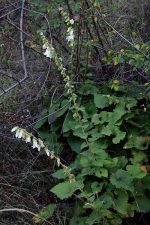A lso known as spurred bellflower, this herbaceous perennial is in the Campanulaceae family that also includes ladybell (Adenophora), Lobelia, and balloon flower. It is native to the Caucasus and Turkey where it grows in open scrub and on wet cliffs and steep banks in spruce forests. Plants grow 18-36″ tall from a tufted rootstock and have simple or branched stems that rise above a clump of roughly hairy, heart-shaped basal leaves that have rounded teeth and are up to 10″ long. One sided racemes of white nodding flowers 1-2″ long appear in the summer. The flowering stems tend to be floppy as the flowers are formed and should be cut back after flowering to maintain a pleasing appearance. Cornish bellflower is a good choice for a wildflower or cottage garden in cool climates. It is not suitable for the South. The generic name, Campanula, is the diminutive of the late Latin word, campana, meaning bell. The specific epithet, alliariifolii, comes from the name of a weedy plant called Alliaria, and the Latin word folia, meaning leaf, and refers to the resemblance of the leaf to that of Alliaria.
lso known as spurred bellflower, this herbaceous perennial is in the Campanulaceae family that also includes ladybell (Adenophora), Lobelia, and balloon flower. It is native to the Caucasus and Turkey where it grows in open scrub and on wet cliffs and steep banks in spruce forests. Plants grow 18-36″ tall from a tufted rootstock and have simple or branched stems that rise above a clump of roughly hairy, heart-shaped basal leaves that have rounded teeth and are up to 10″ long. One sided racemes of white nodding flowers 1-2″ long appear in the summer. The flowering stems tend to be floppy as the flowers are formed and should be cut back after flowering to maintain a pleasing appearance. Cornish bellflower is a good choice for a wildflower or cottage garden in cool climates. It is not suitable for the South. The generic name, Campanula, is the diminutive of the late Latin word, campana, meaning bell. The specific epithet, alliariifolii, comes from the name of a weedy plant called Alliaria, and the Latin word folia, meaning leaf, and refers to the resemblance of the leaf to that of Alliaria.
Type: Herbaceous perennial
Bloom: One sided racemes of white nodding flowers 1-2″ long in the summer.
Size: 18-36″ H x 24″ W
Light:Sun, part shade
Soil:Fertile, moist, well-drained
Hardiness: Zones 3-7
Care: Remove flowering stems after blooming
Pests and Diseases: None of significance
Propagation: Seed, terminal cuttings, root cuttings, division
Companion Plants: Hosta, Geranium, Lupin, Inula, Phlox and ferns
Photo Credit: Franz Xaver Wikimedia Commons